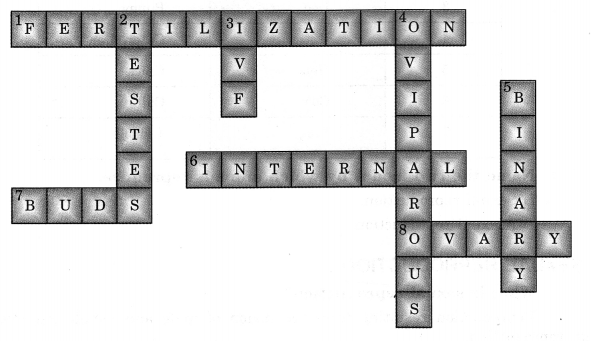NCERT Solutions for Class 8 Science Chapter 9 Reproduction in Animals are part of NCERT Solutions for Class 8 Science. Here we have given NCERT Solutions for Class 8 Science Chapter 9 Reproduction in Animals.
| Board | CBSE |
| Textbook | NCERT |
| Class | Class 8 |
| Subject | Science |
| Chapter | Chapter 9 |
| Chapter Name | Reproduction in Animals |
| Number of Questions Solved | 10 |
| Category | NCERT Solutions |
NCERT Solutions for Class 8 Science Chapter 9 Reproduction in Animals
NCERT TEXTBOOK EXERCISES
Question 1.
Explain the importance of reproduction in organisms.
Answer.
The production of new individuals from their parents is known as reproduction. Reproduction is very important as it ensures the continuation of a species. If the process of reproduction does not exist, the species would get vanished from the earth.
Question 2.
Describe the process of fertilisation in human beings.
Answer.
The first step in the process of reproduction is the fusion of a sperm and an ovum. Millions of sperms from the male are transferred into the female body. The sperms swim in the oviduct with the help of their tails to reach the egg. When they come in contact with the egg, one of the sperms may fuse with the egg.
Such fusion of the egg and the sperm is called fertilization. During fertilization, the nucleus of the sperm and the egg fuse to form a single nucleus. This results in the formation of a fertilized egg or zygote.
Question 3.
Choose the most appropriate answer:
(a) Internal fertilisation occurs
(i) in female body.
(ii) outside the female body.
(iii) in male body.
(iv) outside male body.
Answer.
(i) in female body.
(b) A tadpole develops into an adult frog by the process of
(i) fertilisation.
(ii) metamorphosis.
(iii) embedding.
(iv) budding.
Answer.
(ii) metamorphosis.
(c) The number of nuclei present in a zygote is
(i) none
(ii) one
(iii) two
(iv) four.
Answer.
(ii) one.
Question 4.
Indicate whether the following statements are True (T) or False (F):
- Oviparous animals give birth to young ones. ( )
- Each sperm is a single cell. ( )
- External fertilisation takes place in frogs. ( )
- A new human individual develops from a cell called gamete. ( )
- Egg laid after fertilisation is made up of a single cell. ( )
- Amoeba reproduces by budding. ( )
- Fertilization is necessary even in asexual reproduction. ( )
- Binary fission is a method of asexual reproduction. ( )
- A zygote is formed as a result of fertilisation. ( )
- An embryo is made up of a single cell. ( )
Answer.
- False
- True
- True
- False
- True
- False
- False
- True
- True
- False
Question 5.
Give two differences between a zygote and a foetus.
Answer.
| Zygote | Foetus. |
| 1. It is single-celled. | 1. It is multicellular. |
| 2. Zygote is formed by the fusion of male and female gametes. |
2. Foetus is formed by the repeated division of zygote and differentiation. |
Question 6.
Define asexual reproduction. Describe two methods of asexual reproduction in animals. ‘
Answer.
The type of reproduction in which only a single parent is involved is called asexual reproduction.
Budding: The asexual reproduction in which an individual develops from buds, which is detached from a parent body is known as budding. For example, Hydra reproduces by this method. Many bulges are found in the parent body of hydra. These bulges called buds to develop into new individuals.
Budding fission: It is a type of asexual reproduction in which an animal reproduces by dividing into two individuals. This type of reproduction is observed in the microscopic organism, amoeba. The reproduction in Amoeba begins by a division of its nucleus into two nuclei. This is followed by a division of its body into two with each part receiving a nucleus. Finally, two amoebae are produced from a single Amoeba.
Question 7.
In which female reproductive organ does the embryo get embedded?
Answer.
The embryo gets embedded in the wall of the uterus (of the female) for further development.
Question 8
What is metamorphosis? Give examples.
Answer.
The drastic change that transforms a larva into an adult is called metamorphosis. Frog, SilkWorm, Honeybee, are some animals in which metamorphosis occurs.
Question 9.
Differentiate between internal fertilisation and external fertilisation.
Answer.
| Fertilization |
External fertilisation. |
| 1.Takes place inside the body of the female. |
1. Takes place outside the body of the female. |
|
2. Female lays either fertilized eggs or a fully grown individual is born. |
2. Female lays unfertilized eggs. |
Question 10.
Across
1. The process of the fusion of the gametes.
6. The type of fertilisation in the hen.
7. The term used for bulges observed on the sides of the body of Hydra.
8. Eggs are produced here.
Down
2. Sperms are produced in these male reproductive organs.
3. Another term for in vitro fertilisation.
4. These animals lay eggs.
5. A type of fission in amoeba.
Answer.

We hope the NCERT Solutions for Class 8 Science Chapter 9 Reproduction in Animals help you. If you have any query regarding NCERT Solutions for Class 8 Science Chapter 9 Reproduction in Animals, drop a comment below and we will get back to you at the earliest.